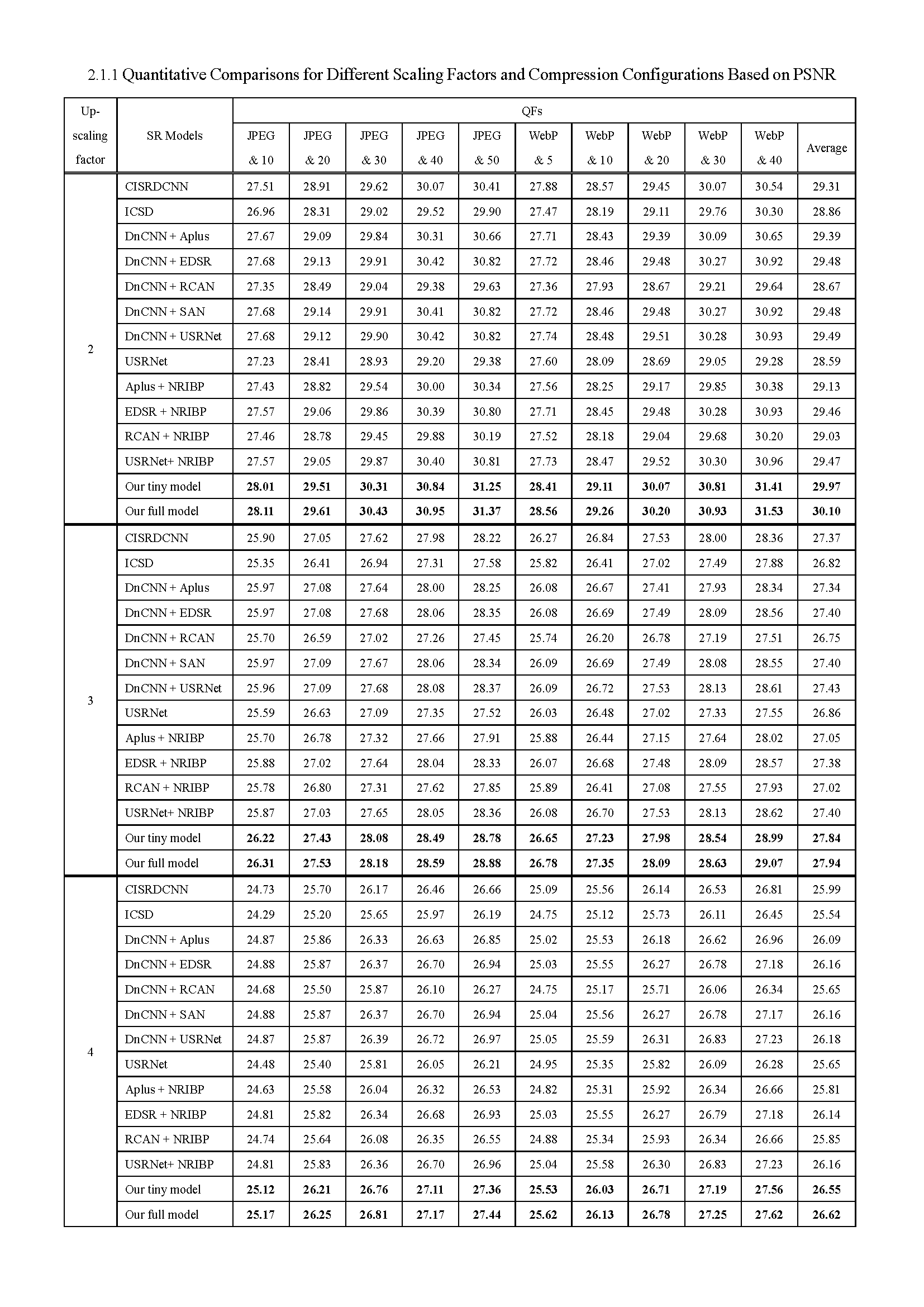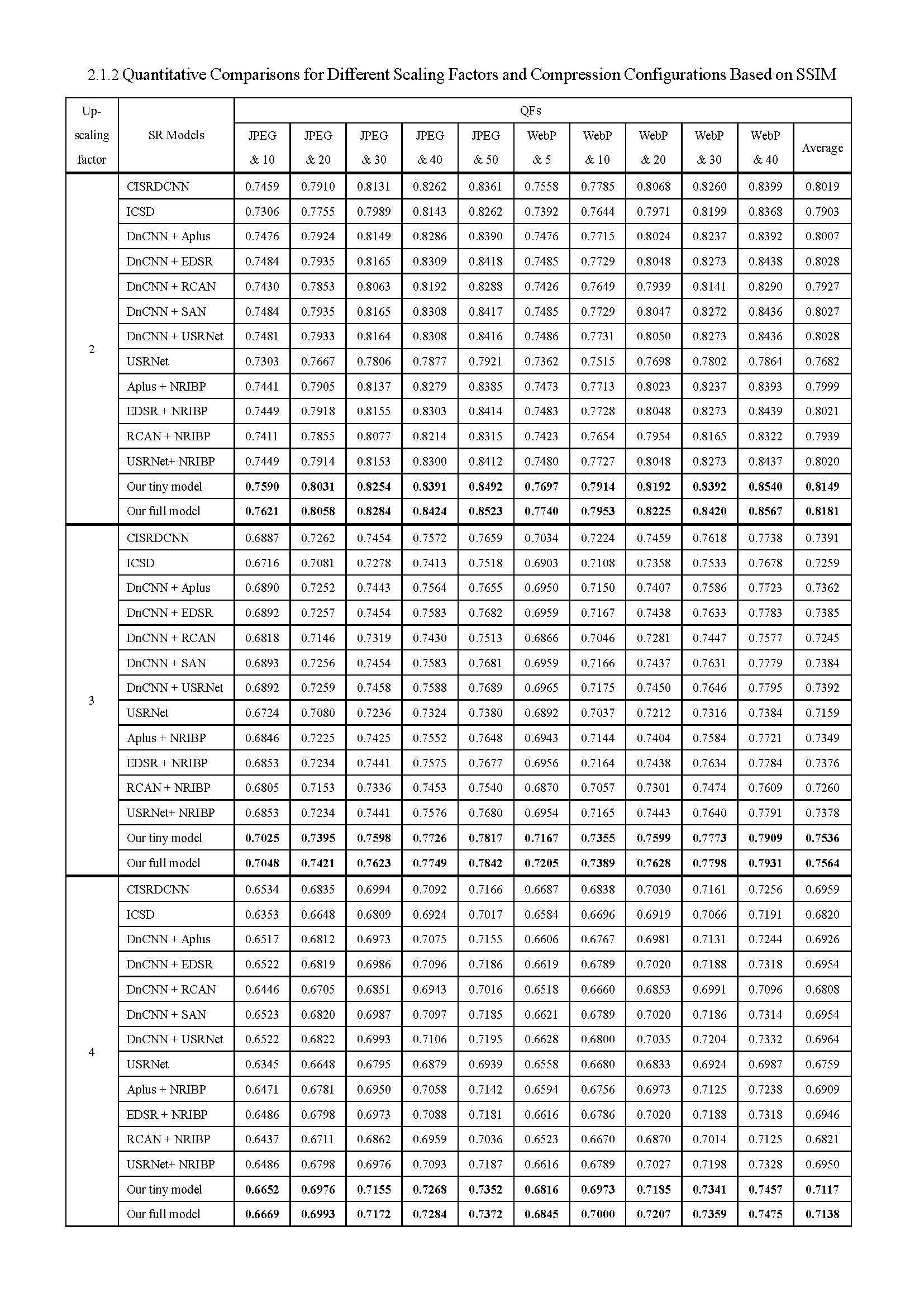
Online Materials of Super-Resolving Compressed Images via Parallel and Series Integration of Artifact Reduction and Resolution Enhancement
Super-Resolving Compressed Images via Parallel and Series Integration of Artifact Reduction and Resolution Enhancement
Hongming Luo, Fei Zhou, Guangsen Liao, Guoping Qiu.
1.Dataset
We collect 76 uncompressed images by ourselves to supplement Kodak24 (http://r0k.us/graphics/kodak/). These images are selected from 1000 images with the size of 3840 * 2160 and cropped as images with the size of 600 * 600. They are from a variety of scenarios including indoors, outdoors, and so on. We prepare these data using MATLAB.
We also build up a dataset containing 50 avatar images from the social media WeChat. Specifically, 5 WeChat users (3 females and 2 males) are selected, and each user is required to provide 10 avatar images from their friend lists after the approval from their friends.
Some results are shown in the following Section, as well as the rest of results can be downloaded in Section. 6.
Download dataset links: VISTA_UCD76_dataset.zip and VISTA_WeChat50_dataset.zip

Thumbnail of UCD76 dataset images.
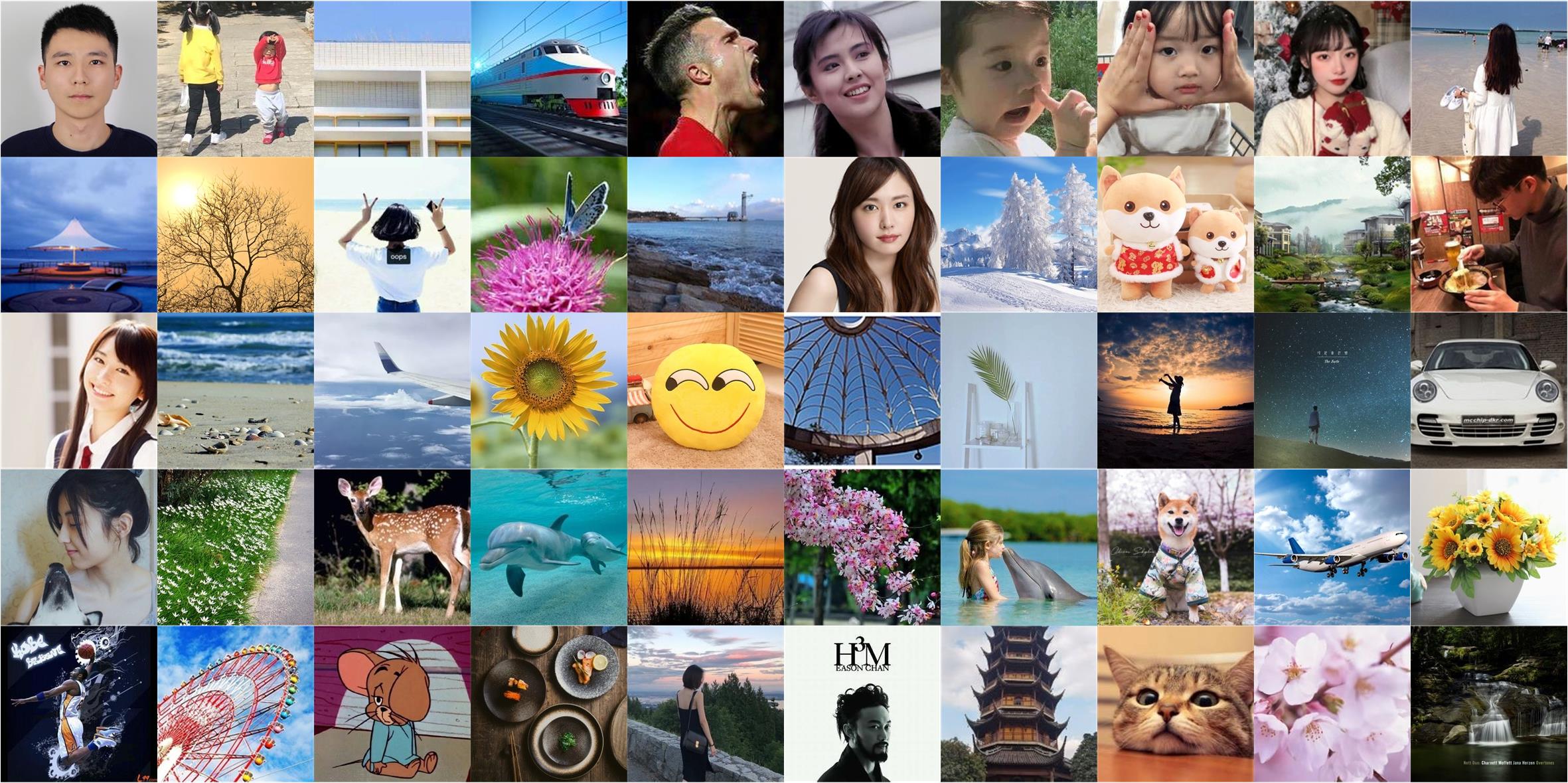
Thumbnail of WeChat avatar dataset images.
2. Comparisons for Super-resolution
down-sampling scale : 2, 3, 4
JPEG QFs : 10, 20, 30, 40, 50
WebP QFs : 5, 10, 20, 30, 40
2.1 Quantitative Comparisons
2.2 Visual Comparisons. (compression type & quality factor & scale)
2.2.1 JPEG & 10 & x2

2.2.2 JPEG & 10 & ×2

2.2.3 WebP & 5 & ×2

2.2.4 JPEG & 20 & ×3

2.2.5 WebP & 20 & ×3

2.2.6 WebP & 30 & ×3

2.2.7 WebP & 40 & ×4

2.2.8 WebP & 40 & ×4

3.Comparisons for Compression Artifacts Reduction
Involved methods: SA_DCT [10], TNRD [11], DnCNN [3], DCSC [12]. Among these compared methods, the inputs of SA_DCT and TNRD are limited to JPEG images. Thus, they are not able to restore WebP images. The best performance is bold and the second one is underlined in the following table.
3.1 Quantitative Comparisons
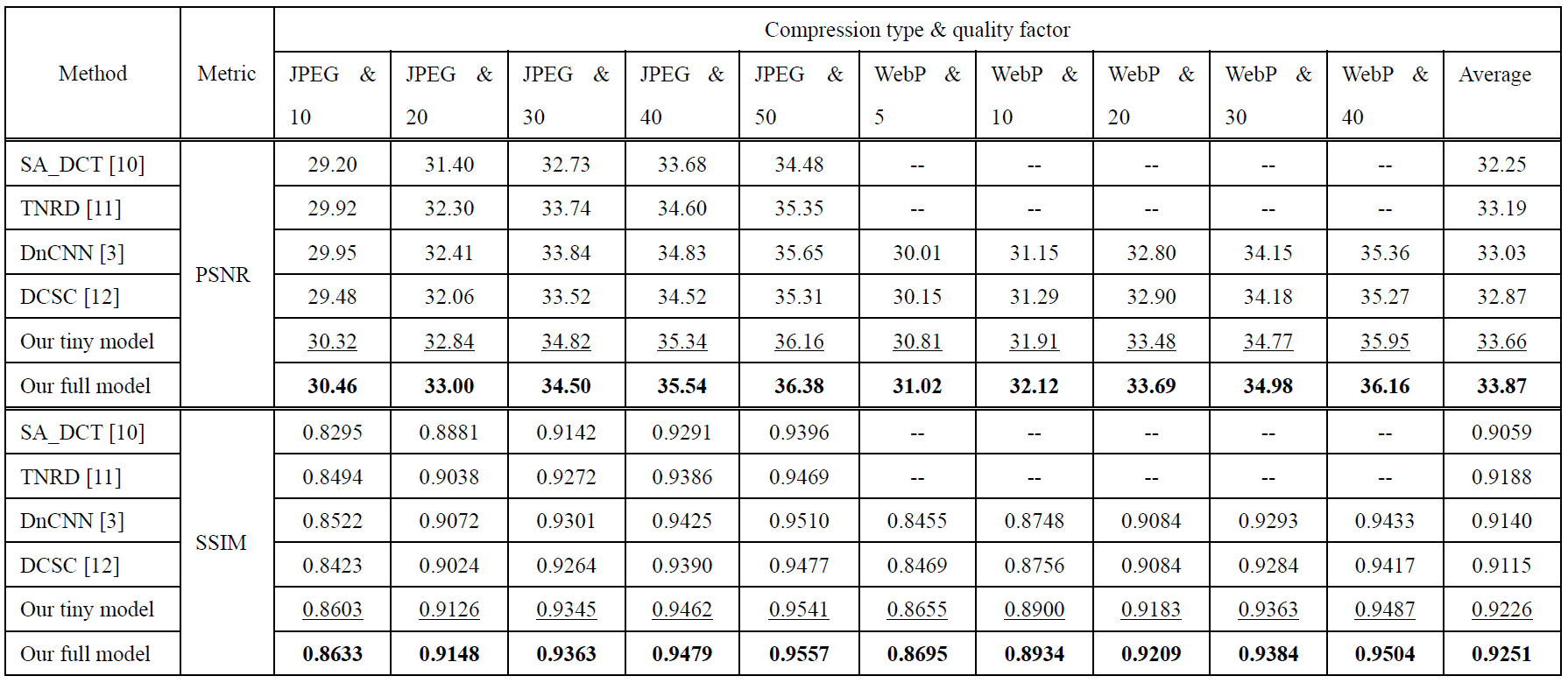
3.2 Visual Comparisons. (compression type & quality factor )
3.2.1 JPEG & 10

3.2.2 WebP & 10

4.Super-resolving Images from Social Media

5.Each time step results
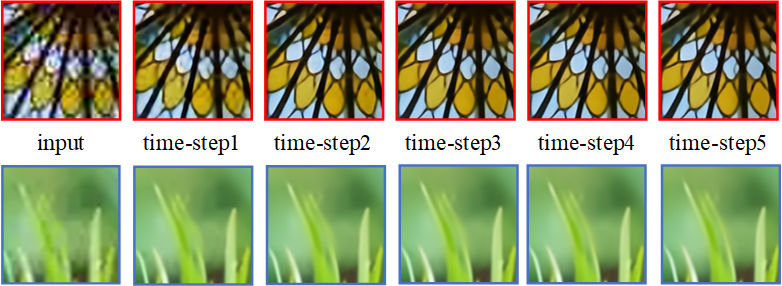
6.Other Information
All of our results are available at:
Baidu Drive link :(https://pan.baidu.com/s/1eF41V3jnQnR_1CwuD1PYkA) password (1xuj)
Google Drive (https://drive.google.com/drive/folders/13oJ1lb-GuAM1OEg6QiXV_gHJ3_y9vlzS)
Code: https://github.com/luohongming/CISR_PSI.
Reference:
[1] T. Li, X. He, L. Qing, Q. Teng, and H. Chen, “An iterative framework of cascaded deblocking and superresolution for compressed images,” IEEE Trans. Multimedia, vil. 20, no. 6, pp. 1305–1320, Jun. 2018.
[3] K. Zhang, W. Zuo, Y. Chen, D. Meng, and L. Zhang, “Beyond a Gaussian Denoiser: Residual learning of deep CNN for image denoising,” IEEE Trans. Image Process., vol. 26, no. 7, pp. 3142–3155, Jul. 2017.
[4] Timofte, V. De, and L. Van Gool, “A+: Adjusted anchored neighborhood regression for fast super-resolution,” in Proc. IEEE Asian Conf. Comput. Vis., 2014, pp. 111–126.
[5] Lim, S. Son, H. Kim, S. Nah, and K. M. Lee, “Enhanced deep residual networks for single image super-resolution,” in Proc. IEEE Conf. Comput. Vis. Pattern Recognit. Workshops, 2017, pp. 1132–1140.
[6] Y. Zhang, K. Li, K. Li, L. Wang, B. Zhong, and Y. Fu, “Image super-resolution using very deep residual channel attention networks,” in Proc. Eur. Conf. Comput. Vis., 2018, pp. 294–310.
[7] T. Dai, J. Cai, Y. Zhang, S-T. Xia, and L. Zhang, “Second-order attention network for single image super-resolution,” in Proc. IEEE Conf. Comput. Vis. Pattern Recognit., 2019, pp. 11057–11066.
[8] K. Zhang, L. V. Gool, and R. Timofte, “Deep unfolding network for image super-resolution,” in Proc. IEEE Conf. Comput. Vis. Pattern Recognit., 2020, pp. 3217–3226.
[9] J.-S. Yoo and J.-O. Kim, “Nosie-robust iterative back-projection,” IEEE Trans. Image Process., vo. 29, pp. 1219–1232, 2020.
[10] Foi, V. Katkovnik, and K. Egiazarian, “Pointwise shape-adaptive DCT for high-quality denoising and deblocking of grayscale and color images,” IEEE Trans. Image Process., vol. 16, no. 5, pp. 1395–1411, May 2007.
[11] Chen and T. Pock, “Trainable nonlinear reaction diffusion: A flexible framework for fast and effective image restoration,” IEEE Trans. Pattern Anal. Mach. Intell., vol. 39, no. 6, pp. 1256–1272, Jun. 2017.
[12] Fu, Z.-J. Zha, F. Wu, X. Ding, and J. Paisley, “JPEG artifacts via deep convolutional sparse coding,” in Proc. IEEE Int. Conf. Comput. Vis., 2019, pp. 2501–2510.
